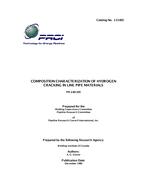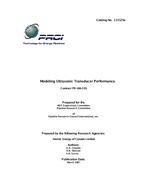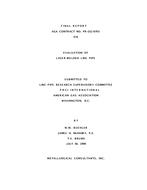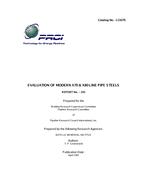Provide PDF Format
PRCI PR-140-105
- Composition Characterization of Hydrogen Cracking in Line Pipe Materials
- Report / Survey by Pipeline Research Council International, 12/01/1980
- Publisher: PRCI
$98.00$195.00
L51402e
Welding Institute of Canada
Need: For many years, researchers have been assessing test methods to check the field welding behavior of pipeline steels. The results of all these tests have been inconclusive, and no real correlation has been established. It has been found that they are only suitable to classify the steel in terms of its weldability. This weldability has been specified in terms of a simple carbon equivalent (C.E.) formula. This formula has worked especially well for the higher carbon material because as a rough index of hardenability it indicated the probability of forming a hard HAZ susceptible to cracking. There is a need for an accurate model to predict weld cracking susceptibility.
Result: A model has been established (based on the present results and on previous published data) to predict the effect of preheat, hydrogen and chemical composition on cracking in welds. This has been based on cracking occurring if the average hydrogen concentration remaining in the weld exceeds a critical value depending on the composition. Hence, the model is based on the diffusion of hydrogen. The response of the heat-affected zones of micro-alloy and low-alloy line pipe steels to changes in cooling rate can be represented by a hardening curve. The slope of the hardening curve is of fundamental importance in considering possible welding procedures to avoid cracking. The maximum hardness obtained in the HAZ from very fast cooling rates can best be indexed in terms of the steels carbon content. The critical cooling rate to produce a given hardness has been shown to relate to a carbon equivalent formula.
Benefit: This study has investigated the effect of composition of a series of line-pipe steels on their cracking tendency using small-scale, self-restrained tests and their correlation with the C.E. formulae. The pipeline steels studied included conventional C-Mn, quenched-and-tempered, pearlite-reduced and MnMoNb types. The work was carried out in three phases. Phase I was an assessment of the hardening characteristics of the HAZ and its relationship to C.E. Phase 2 was a study of Y-groove restrained tests using high and low hydrogen processes, changing preheat and varying input levels. Phase 3 was a limited study of the effect of full-section weldments on HAZ properties.
Welding Institute of Canada
Need: For many years, researchers have been assessing test methods to check the field welding behavior of pipeline steels. The results of all these tests have been inconclusive, and no real correlation has been established. It has been found that they are only suitable to classify the steel in terms of its weldability. This weldability has been specified in terms of a simple carbon equivalent (C.E.) formula. This formula has worked especially well for the higher carbon material because as a rough index of hardenability it indicated the probability of forming a hard HAZ susceptible to cracking. There is a need for an accurate model to predict weld cracking susceptibility.
Result: A model has been established (based on the present results and on previous published data) to predict the effect of preheat, hydrogen and chemical composition on cracking in welds. This has been based on cracking occurring if the average hydrogen concentration remaining in the weld exceeds a critical value depending on the composition. Hence, the model is based on the diffusion of hydrogen. The response of the heat-affected zones of micro-alloy and low-alloy line pipe steels to changes in cooling rate can be represented by a hardening curve. The slope of the hardening curve is of fundamental importance in considering possible welding procedures to avoid cracking. The maximum hardness obtained in the HAZ from very fast cooling rates can best be indexed in terms of the steels carbon content. The critical cooling rate to produce a given hardness has been shown to relate to a carbon equivalent formula.
Benefit: This study has investigated the effect of composition of a series of line-pipe steels on their cracking tendency using small-scale, self-restrained tests and their correlation with the C.E. formulae. The pipeline steels studied included conventional C-Mn, quenched-and-tempered, pearlite-reduced and MnMoNb types. The work was carried out in three phases. Phase I was an assessment of the hardening characteristics of the HAZ and its relationship to C.E. Phase 2 was a study of Y-groove restrained tests using high and low hydrogen processes, changing preheat and varying input levels. Phase 3 was a limited study of the effect of full-section weldments on HAZ properties.
Related Products
PRCI NX-37
Pipetran Version IV - A Digital Computer Program for the Simulation of Gas Pipeline Network Dynamics..
$6.00 $12.00





